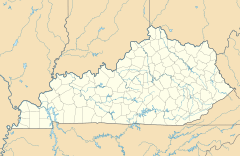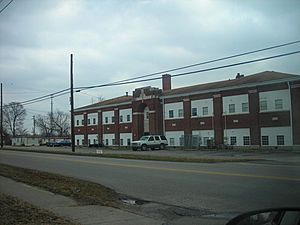Weaverton, Henderson County, Kentucky facts for kids
Quick facts for kids
Weaverton
|
|
|---|---|
| Country | United States |
| State | Kentucky |
| County | Henderson |
| Elevation | 397 ft (121 m) |
| Time zone | UTC-6 (Central (CST)) |
| • Summer (DST) | UTC-5 (CST) |
| GNIS feature ID | 506322 |
Weaverton is a neighborhood in Henderson, Kentucky, United States. It used to be an unincorporated community and a coal town. Today, people often call it the East End of the South Side of town. Its borders are Loeb Street to the east, Atkison Street to the south, Madison Street and Pringle Street to the west, and Mill Street and Meadow Street to the north. The old Weaverton High School, which is now Weaverton Apartments, is a key landmark in this area.
Contents
Weaverton's Past
People living in the East End today might not know the exact borders of Weaverton. But from the 1870s until recently, farmers from the southern part of the county knew Weaverton very well.
Early Businesses and Trade
In 1871, George Vogel started a general store. It had a watering spot for horses and drinks for farmers. Later, two coal mines opened in Weaverton. There were also corn bins and a stockyard. This allowed farmers to trade their crops for things they needed. Many times, a "trip to town" meant stopping in Weaverton.
Growth of Industries
The Weaverton Milling Co. started in 1911. In 1913, the Weaverton Lumber Company took over from Ambrose Lumber Yards. The Kleymeyer Brickyards, which began in 1868, might also be considered part of Weaverton. This is true if Clay Street is seen as the boundary.
Weaverton Schools
The old Weaverton grade school was located east of Atkinson Street, off Pringle. It existed as early as 1889. The school was torn down around 1916 or 1918. Both it and the old Audubon School were part of the county school system.
School Desegregation
In 1957, schools in the neighborhood became desegregated. This meant students of all races could attend together. Three young Black students, James W. Clancey Jr., Shane Dunise Bushrod, and Alvin Eugene Barnes, bravely signed up for Weaverton Elementary School. They were the first Black students to register and attend classes as equals with white students in the area. When they enrolled, many white students left the school in protest. However, about half of the 872 children stayed in class.
The Wagon Works Factory
In 1903, the Coquillard Wagon Works moved to Weaverton from South Bend, Indiana. Their new factory was built right over a swimming hole that the Vogel boys used. When local business owners bought shares in the company, its name changed to Henderson Wagon Works. This factory made 600 horse-drawn wagons each year. However, a money crisis in 1913–1914 caused Sears, Roebuck Co. to stop buying them. Later, the factory was used by Heinz Cannery and Atlas Tack Co. A huge fire destroyed the factory in the summer of 1978. People reported seeing smoke and flames from 10 to 15 miles away.




